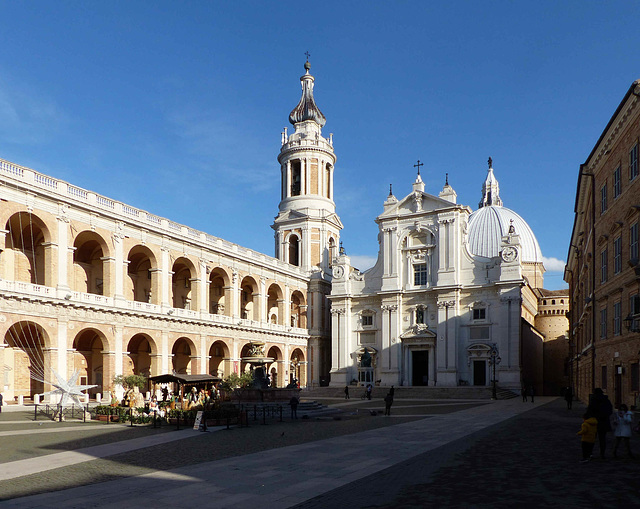Location
Lat, Lng: 43.441052, 13.610323
You can copy the above to your favourite mapping app.
Address: Chiesa Di Santa Maria Di Loreto
You can copy the above to your favourite mapping app.
Address: Chiesa Di Santa Maria Di Loreto
Keywords
Authorizations, license
-
Visible by: Everyone -
All rights reserved
-
72 visits
Loreto - Basilica della Santa Casa


Loreto is commonly known as the seat of the Basilica della Santa Casa, a popular Catholic pilgrimage site for many centuries.
The story is a little complex. Since the early centuries of the Christian era, tradition claimed that the house of the Virgin was in Nazareth, where she was born, grew up, and where the announcement of the Archangel Gabriel took place. After the resurrection, the apostles would have gathered in this house and celebrated the Eucharist according to the teachings of Jesus
At the beginning of 1291 Nazareth was dominated by the Egyptian Mamluks. So some angels took the Santa Casa and carried it away. In May 1291, the angels left the house near the town of Fiume, where woodcutters found the small dwelling. However, in this place, the pilgrims were often victims of criminals. So, about three years later, the angels recaptured the Holy House and set out with it, and placed it near Ancona. The Holy House remained in this place for nine months, then the angels erected it again and placed it further south, in the village of Banderuola.
Shepherds who saw a bright light coming from the clouds and behind the light found the house. However, the place was too close to the sea and therefore exposed to the dangers of Turkish raid. Eight months later the house was again moved by the angels, this time to Monte Prodo on land belonging to Counts Stefano and Simone Rinaldi di Antici. The brothers soon benefited from the pilgrimages of the faithful to the point of petitioning the Pope, to become owners So again the angels raised the Holy House in flight and placed it at the end of 1296 in the middle of the road leading from Recanati to its port, and thus in a public place that no one could claim and exploit. The site chosen was the top of a hill covered with laurel. From the Latin word laurus the place was called Lauretum, that is Loreto.
The basilica containing the Santa Casa is a Late Gothic structure built starting in 1468 and continued by Giuliano da Maiano, Giuliano da Sangallo, and Donato Bramante. It is 93 meters long, 60 meters wide, and its campanile is 75 meters high.
The story is a little complex. Since the early centuries of the Christian era, tradition claimed that the house of the Virgin was in Nazareth, where she was born, grew up, and where the announcement of the Archangel Gabriel took place. After the resurrection, the apostles would have gathered in this house and celebrated the Eucharist according to the teachings of Jesus
At the beginning of 1291 Nazareth was dominated by the Egyptian Mamluks. So some angels took the Santa Casa and carried it away. In May 1291, the angels left the house near the town of Fiume, where woodcutters found the small dwelling. However, in this place, the pilgrims were often victims of criminals. So, about three years later, the angels recaptured the Holy House and set out with it, and placed it near Ancona. The Holy House remained in this place for nine months, then the angels erected it again and placed it further south, in the village of Banderuola.
Shepherds who saw a bright light coming from the clouds and behind the light found the house. However, the place was too close to the sea and therefore exposed to the dangers of Turkish raid. Eight months later the house was again moved by the angels, this time to Monte Prodo on land belonging to Counts Stefano and Simone Rinaldi di Antici. The brothers soon benefited from the pilgrimages of the faithful to the point of petitioning the Pope, to become owners So again the angels raised the Holy House in flight and placed it at the end of 1296 in the middle of the road leading from Recanati to its port, and thus in a public place that no one could claim and exploit. The site chosen was the top of a hill covered with laurel. From the Latin word laurus the place was called Lauretum, that is Loreto.
The basilica containing the Santa Casa is a Late Gothic structure built starting in 1468 and continued by Giuliano da Maiano, Giuliano da Sangallo, and Donato Bramante. It is 93 meters long, 60 meters wide, and its campanile is 75 meters high.
Marco F. Delminho, Paolo Tanino, Eric Desjours have particularly liked this photo
- Keyboard shortcuts:
Jump to top
RSS feed- Latest comments - Subscribe to the comment feeds of this photo
- ipernity © 2007-2025
- Help & Contact
|
Club news
|
About ipernity
|
History |
ipernity Club & Prices |
Guide of good conduct
Donate | Group guidelines | Privacy policy | Terms of use | Statutes | In memoria -
Facebook
Twitter











Sign-in to write a comment.